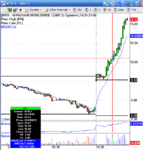tradespreads
Member
- Messages
- 76
- Likes
- 0
Cryoplasm,
Whole numbers often act as support and resistance levels. See attached an example from this afternoon, 54.00 acting as a clear resistance level.
BTW I don't use technical indicators, they are normally based on the price, if the price moves up/down so do they, I think you can just use the price itself (just my humble opinion).
I use price (direction), volume (strength) and ATR (as a measure of volatility).
Without parading off-topic too much on this discussion..
Now, your argument is completely unconvincing :!: From your example, S/R could well have been 53.99 or 54.01 (real nos). The fact it was 54.00 (integer) is purely coincidental. One could derive additional regions of S/R in previous timeframes at which price points are not integers but real numbers. Integers are real numbers but not all real numbers are integers.

